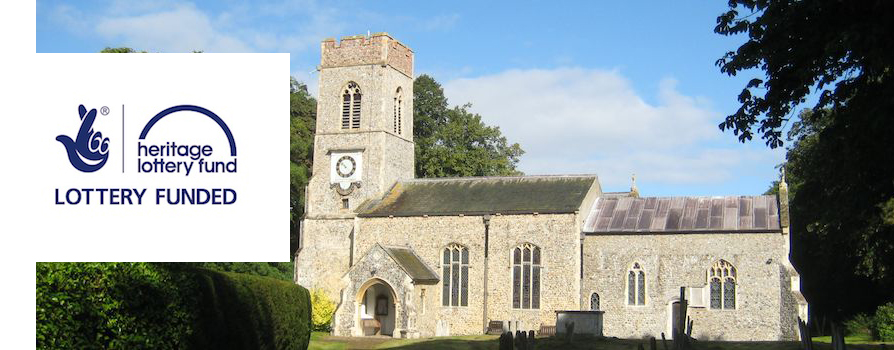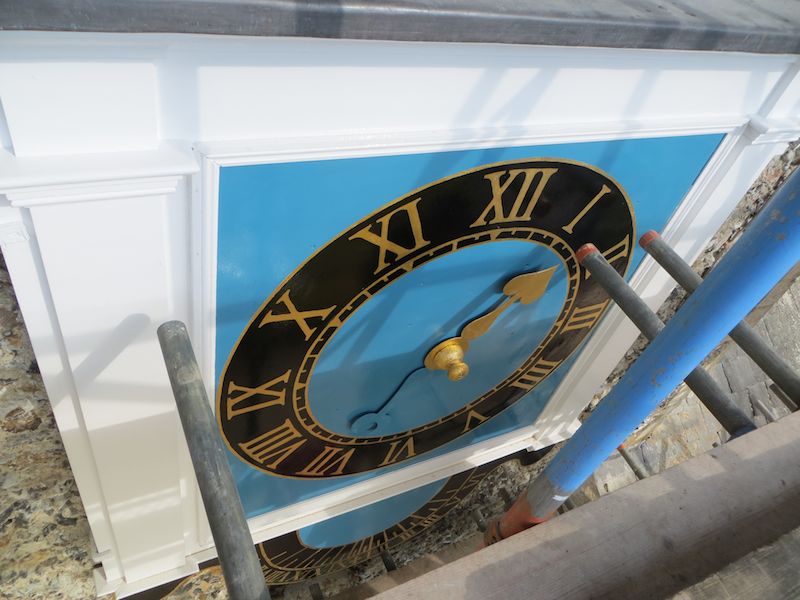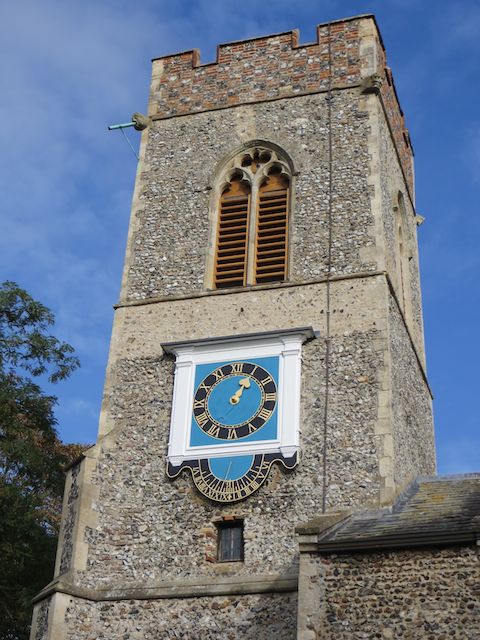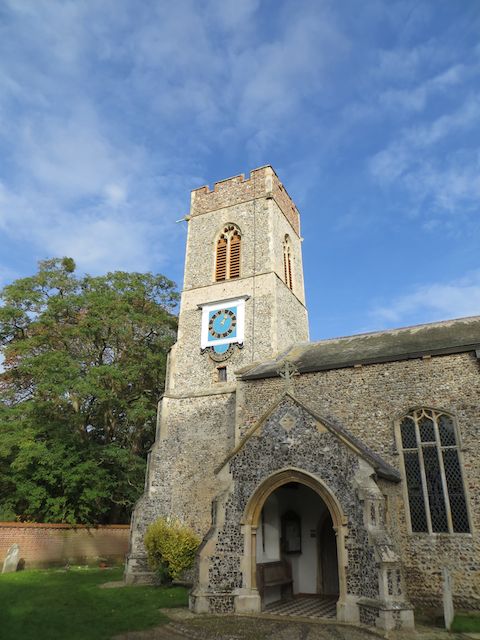The old fifth bell, now stored in the clock chamber, is inscribed:
JOHN BREND II 1651
The new fifth bell is inscribed:
HAPPY MEMORIES OF THE PAST
JOYFUL MOMENTS OF THE PRESENT
AND THE HOPE AND ASPIRATIONS
FOR THE FUTURE
IN MEMORY OF
ROBERT SWINCHATT

The old fourth bell, now stored in the clock chamber, is inscribed:
1618
Plus the mark of William and Alice Brend
The new fourth bell is inscribed:
GIVEN BY
TREVOR JOHN STEVENS AND
TERESA SUSAN STEVENS (NEE CROWDER)
CELEBRATING THE 25TH
ANNIVERSARY OF THEIR MARRIAGE
ON 5TH MARCH 1988
AT MULBARTON CHURCH
AND THEIR LIFE IN SAXLINGHAM
The old second bell was inscribed:
MEARS AND STAINBANK, FOUNDERS, LONDON, 1908
WE PRAISE THEE, O GOD
on the reverse
DAY
HUNG
US
(The bell-hangers were from Eye, hence the eye symbol, “Day of Eye hung us”.)
The new second bell is inscribed:
IN MEMORY OF
GEOFFREY SPENCER ROBERTS
1941 – 2005
LYNN AND STORM ROBERTS
This is the first of eight posts – one for each bell – noting the inscriptions from the old bell and its replacement.
Mears and Stainbank is now known as The Whitechapel Foundry.
The old treble bell was inscribed:
MEARS AND STAINBANK, FOUNDERS, LONDON
THE TREBLE AND 2ND BELL WERE GIVEN
TO COMPLETE THE OCTAVE
BY
R. W. PITT., RECTOR
1908
The new treble bell is inscribed:
REMEMBER BEFORE GOD
PAUL CATTERMOLE
1941-2009

The Ringers on 9th February 2014 – from left to right: Neil Thomas, Peter Trent, Peter Sawyer, Simon Rudd, Ros Burrough, Pauline Curtis, Jeff Fox, Aubrey Forster.
The report for Ringing World included the following details:
“Sunday, 9th February 2014 in 2:46 (7-3-27)
5152 Plain Bob Major
Composed by GAA Taylor
The first peal on the new ring of bells, dedicated on 26th January. With best wishes to Michael Stokes who was to have rung today.”
On Sunday 26th January 2014 we welcomed The Right Revd Graham James, The Bishop of Norwich to our church to dedicate the bells.
We also welcomed many guests including representatives of the bell foundry, the builders, the stonemason, the headmistress of the village school and many of the bell-ringing community alongside many people from the parish and regular church-go-ers. All in all over 100 people joined us to celebrate our new peal of eight.
The Revd Sally Gaze led the service which included readings by Mrs. Celia Blyth and Mrs. Barbara Cattermole and a specially written song performed by the choir.
The bells returned to the village on 6th December and were hung in time for their debut at Midnight Mass on Christmas Eve.
The old bell from 1616 has been re-hung as the clock bell and the linkage to the clock is being worked on at present.
We are grateful to the Bishop of Norwich, The Right Revd. Graham James, who will be visiting the church on 26th January to bless and dedicate the bells. Everyone is welcome to attend the service which will begin at 11am.
After the service there will be a buffet lunch – if you would like to attend the lunch you must sign the sheet at the back of the church by Monday the 20th January before 4pm. We need to have numbers for catering ready on Monday evening and, sadly, will be unable to cater for anyone who doesn’t sign up. If you have signed a previous sheet there is no need to sign up again, your name will already be down!
(Apologies for the lack of photographs and slow update – the internet gremlins have had a good start to the New Year.)
…here are a few more pictures of the tower work. We are very lucky to have had Roger and Will Tyrrell work on the tower – they have been extremely helpful and accommodating with all our questions and requests to take photos during their work.
 The clock face being re-installed
The clock face being re-installed
Will finishing off the gold leaf on the clock face.
 The clock with the scaffolding down.
The clock with the scaffolding down.
The new louvres covering the sound openings – the wood will darken before reaching it’s final colour, but here it is freshly oiled.
The new string course on the North face of the tower.
Repairing the stone work.
The finished gargoyle.
A grotesque with repaired string course to the right.
The tower – showing the fresh lime mortar in the flint work.
 The tower gleaming in the autumn sunlight – yes, we have had some sunlight this autumn!
The tower gleaming in the autumn sunlight – yes, we have had some sunlight this autumn!
The new bells will be arriving shortly and the current aim is for the first service with the new bells to be Midnight Mass on Christmas Eve.
Many thanks to Roger and Will Tyrrell for their help and all their work on the tower.
On the morning of Saturday 21st September a group of ten people met in the church room to learn about genealogy.
Lynn started the session with a discussion of the definition of genealogy and some of the resources available to the family historian. She talked about some of the difficulties those researching their family history might encounter – for example transcription errors by enumerators at a census or Registrars when writing out a copy of a certificate or transcribing register entries onto the computer system. She also pointed out that sometimes the information given to the Registrar was incorrect (nowadays to give incorrect information is perjury) – in Victorian times many marriages involved young people who were 21 years old (the age from when no parental consent was required for marriage) many may have been 21 but some could well have been a little younger. On some marriage certificates the age is given as “OFA” (Of Full Age) which is not very helpful for a family historian!
One aspect covered in this session was how to research Scottish ancestors – the legal system in Scotland is different and so is the record keeping which throws up some interesting points for the family historian. In someways Scotland’s records are more helpful as they include more information however this can lead to confusion. Joan took us through her research into her family’s Scottish side and explained the naming conventions (a first born son would take his paternal grandfather’s name, a second born son his maternal grandfather’s name for example) prevalent in Scotland until recent years.
Lynn and Joan showed the group documents they had uncovered in their research, explained where they came from and exactly what was on each source document. They also explained that however official a source might be it is not necessarily correct – illiteracy (and presumed illiteracy) led to many errors as did simple incorrect information. Joan found a Scottish death certificate for one of her relatives where a nephew (she has been unable to trace this nephew’s connection to the family) stated that her relative’s father was “Adam” where she believes it was “Alexander”. This has introduced uncertainty into Joan’s research and it will not be easy for her to confirm the correct name as it is probable any previous births, marriages or deaths occurred before registration was introduced. Both Lynn and Joan emphasised that it is all too easy to make assumptions and “adopt” ancestors – however infuriating it may be sometimes you just can’t find the person you are looking for. Perseverance is the answer, keep looking!
We discussed how other aspects of life can be useful in family history. Lynn explained that five generations of her family worked in the cotton mills – from the very start to the very end of the industry in Lancashire – if she found two similar records looking at the occupation noted in the register or census could be used as a clue as to which person was more likely to be family and thus where to focus her research.
Another example The Norfolk Association of Bell-Ringers keep records and have allowed us to see that here in Saxlingham Nethergate a George Poyntz rang bells for many, many years – in fact we know that there were two George Poyntz, a father and son. Such information does not prove a relationship but it can be a clue and it helps to add colour to our ancestors’ life.
Many thanks to Lynn and Joan for a very interesting session.